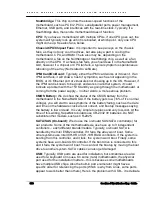
G A L A X Y ® A U R O U R A C O N F I G U R A T I O N A N D S Y S T E M I N T E G R A T I O N G U I D E
118
Section 4 Troubleshooting Guide
4.14
SAS / Infiniband Host connectivity issues
This is more of a tip than for troubleshooting. The cable is not very easy to
damage. The main problem area is: “I can’t get the cable out.” At the front of
the cable are two pairs of metal hooks which hook onto the socket. If you pull
on the cable really hard, and pull on the release really hard, the cable might
not come out – this is because you are trying too hard, and are actually pulling
the hooks against the socket harder than the release is trying to release them.
If this occurs, while holding the release on the cable, push the cable in (instead
of out), and you will hear the latches release, then pull the cable out.
4.15
Fibre HBA problems
Note that this card is especially delicate – not so much in terms of ESD, but in
regards to the physical components on the card. If the Fibre shields become
damaged or distorted, it might not be possible to properly insert SFPs into
them. Also on the back are a series of very tall surface-mount components
(specifically some capacitors) – if these are broken off, specific ports won’t
work. These aside, single ports can fail, and multiple ports can fail. If all ports
fail, try swapping the card, otherwise check the software, then the cables, then
the SFPs. These small SFP is almost an entire computer in itself, with it’s own
PIC processor, RAM, signal noise filter, retimer, amplifier, laser diode, and
optical detector. If any components in an SFP fail, it is not serviceable, and
should be replaced. You can observe the output of the laser (carefully, but not
too close). If there is no light, and the SFP is fully-inserted, either the device it
is plugged into is not providing power, or the SFP is bad.
4.16
Fibre Host connectivity issues
Of all of the possible cables in Aurora’s RAID system, by far, the most delicate
are Fibre Channel cables. The amount of problems that is possible with these
cables is somewhat astronomical compared with other cables. First a
description of how they are constructed: There are two optical conduits in a
standard LC cable, one carrying light to the array’s SFP, and one bringing light
back. The diameter of this conduit is much larger than the width of the laser
beam projected into it, but the cable is designed to bounce the beam off the
inner sides of the fibre conduit. At the ends of these conduits are a pair or
lenses. These lenses are glued on carefully, by hand, and do two things: 1)
Protect the ends of the fibre conduit itself, and 2) Focus the beam to a point
















































